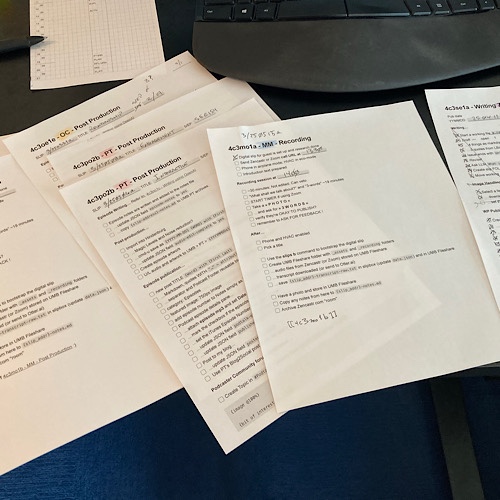What does it really mean to be an effective podcast host?
Good podcasts succeed by focusing on engagement, not biography.
[…] everybody loves podcasting and talks about their podcast constantly, and yet never talks about hosting— how can I be a better host?
~ Vince Quinn (2:00)
This conversation with Vince Quinn focuses on the role of hosting in podcasting, emphasizing that many podcasters neglect to develop hosting as a craft. The discussion contrasts how people obsess over gear or downloads but rarely consider how to become better hosts. A strong host is seen as fundamental to a good show—someone who prepares, guides the conversation, and stays aware of pacing, clarity, and energy. The act of listening back to one’s own show is framed as a vital method of improving, not just through passive review but through strategic reflection on structure, tone, and listener engagement.
Vince and Craig also discuss common pet peeves in podcasting, such as hosts who aren’t prepared or who rely on generic question lists. They stress that shows should begin with engaging topics, not guest biographies, and that silence and space are useful tools for dynamic audio. Another significant topic is the use of LinkedIn and other platforms not just for promotion but for building real, reciprocal connections. The conversation closes with reflections on using podcasts as core drivers of content strategy for small businesses, suggesting that most podcasters follow flawed blueprints and should instead focus on clarity of purpose and realistic goals.
Takeaways
Hosting as the core skill — Hosting is the defining feature of a podcast and is rarely given the attention it deserves.
Listening back with purpose — Reviewing episodes is essential for improvement, especially when done with detachment and intention.
Preparation makes a difference — Being prepared with guest-specific context creates a better experience for both guest and audience.
Avoiding biography overload — Starting episodes with long guest bios wastes listener attention and can be a major turnoff.
Letting guests lead — Asking neutral, open-ended questions enables guests to share authentic experiences without emotional projection.
Using space intentionally — Strategic use of silence can enhance tension, rhythm, and storytelling in audio.
Engaging social media mindfully — LinkedIn and other platforms can be used effectively to build strategic business relationships.
Avoiding generic questions — Personalized, thoughtful prompts are more engaging than standard interview scripts.
Choosing the right content blueprint — Most podcasters imitate high-profile shows without realistic alignment to their own goals.
Using podcasting for business — Podcasts can drive content strategy, relationship-building, and lead generation for service-based businesses.
Maximizing limited resources — Bootstrapped creators can use a podcast to generate multi-purpose content across platforms efficiently.
Clarity of purpose — Defining success and setting short-term goals are crucial for keeping podcast production focused and meaningful.
Resources
SBX Productions — Vince Quinn’s business providing podcast production services.
Vince’s free 30-minute consultations — To help creators improve their shows.
It’s Not “Just Talking” — Vince’s podcast
(Written with help from Chat-GPT.)
ɕ



